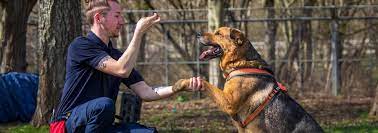Dog’s Training: A Path to a Well-Behaved Companion
Training your dog is not just about teaching them basic commands; it is a journey that strengthens the bond between you and your furry friend. A well-trained dog is not only a joy to be around but also a responsible member of society. In this article, we will explore the importance of dog training and provide some valuable insights into effective training techniques.
The Benefits of Dog Training
Training your dog has numerous benefits that go beyond just obedience. Here are some key advantages:
- Improved Communication: Through training, you establish clear communication channels with your dog, allowing for better understanding and cooperation.
- Better Control: Proper training equips you with the tools to manage your dog’s behavior in various situations, ensuring their safety and the safety of others.
- Socialization Skills: Training helps dogs develop good social skills, enabling them to interact positively with other animals and people.
- Mental Stimulation: Engaging in training activities keeps your dog mentally stimulated, preventing boredom and destructive behaviors.
- Bond Strengthening: The training process fosters trust and strengthens the bond between you and your canine companion.
Effective Dog Training Techniques
To achieve successful training outcomes, it is essential to employ effective techniques. Here are some tried-and-tested methods:
- Positive Reinforcement: Reward-based training, using treats, praise, and play, reinforces desired behaviors and encourages your dog to repeat them.
- Consistency: Consistency is key in training. Establish clear rules and routines, and ensure that all family members follow them consistently.
- Patience: Dogs learn at their own pace. Stay patient and avoid getting frustrated. Celebrate small victories along the way.
- Clicker Training: Clicker training involves using a clicker to mark desired behaviors, followed by a reward. This technique helps dogs associate the sound of the clicker with positive reinforcement.
- Professional Guidance: Consider enrolling in a dog training class or seeking guidance from a professional trainer who can provide expert advice tailored to your dog’s specific needs.
The Training Journey
Dog training is an ongoing process that requires dedication and consistency. Start with basic commands such as sit, stay, and come, gradually progressing to more advanced skills. Remember that each dog is unique, so adapt the training methods to suit their temperament and learning style.
Make training sessions fun and engaging for both you and your dog. Use rewards to motivate them and always end on a positive note. Incorporate regular exercise into your routine as it helps release excess energy and promotes focus during training sessions.
A Well-Behaved Companion Awaits!
Investing time in your dog’s training is a rewarding experience that will result in a well-behaved companion for life. Remember to be patient, consistent, and always use positive reinforcement techniques. With dedication and love, you can shape your furry friend into an obedient and happy member of your family.
Five Essential Tips for Effective Dog Training: Consistency, Positive Reinforcement, and More
Consistency is key
Consistency is key when it comes to training your dog. Dogs thrive on routine and clear expectations, so it’s important to establish consistent rules and boundaries from the start. By being consistent in your commands, rewards, and consequences, you provide your dog with a clear understanding of what is expected of them. This helps to reinforce desired behaviors and prevent confusion or frustration. Consistency also extends to all family members or individuals involved in the dog’s training, ensuring that everyone follows the same guidelines. Remember, dogs learn best when they can rely on a consistent and predictable environment, making consistency an essential element for successful training outcomes.
Positive reinforcement
Positive reinforcement is a highly effective technique in dog training that focuses on rewarding desired behaviors rather than punishing unwanted ones. By using treats, praise, or play as rewards, we can motivate our dogs to repeat the behaviors we want them to learn. This approach not only strengthens the bond between us and our furry companions but also creates a positive and enjoyable learning environment. Dogs respond well to positive reinforcement, as it encourages them to engage in the training process willingly and happily. By focusing on rewarding their good actions, we can shape their behavior in a gentle and humane way, resulting in a well-behaved and happy dog.
Start early
Starting early is a crucial tip when it comes to training your dog. Puppies are like sponges, eagerly soaking up information and experiences from their surroundings. By beginning their training at a young age, you can establish good habits and prevent the development of unwanted behaviors. Early training helps puppies understand boundaries, learn basic commands, and socialize with other dogs and people. It sets a solid foundation for their future behavior and ensures they grow into well-mannered and obedient adult dogs. Remember, the earlier you start, the better equipped your furry friend will be to navigate the world around them.
Patience is important
When it comes to dog training, patience is of utmost importance. Dogs learn at their own pace, and it’s essential to remain calm and patient throughout the process. Rushing or becoming frustrated can hinder their progress and create a negative learning environment. Training requires repetition, consistency, and understanding that not every dog will grasp concepts immediately. By maintaining patience, you allow your dog to learn and grow at their own speed, resulting in a more successful and harmonious training experience for both of you.
Socialize your dog
Socializing your dog is a crucial aspect of their training journey. By exposing your furry friend to various environments, people, and other animals, you help them develop the necessary social skills to navigate the world with confidence. Socialization teaches dogs how to interact appropriately, reducing the likelihood of fear or aggression towards unfamiliar situations. It also promotes a positive attitude towards new experiences, making outings and encounters more enjoyable for both you and your canine companion. Remember, early and ongoing socialization is key to raising a well-rounded and sociable dog that can adapt to different environments with ease.

